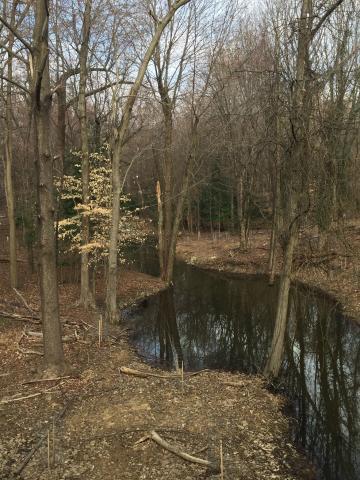
The Campus Creek restoration, completed Nov. 2019, is an environmental restoration project, designed to address stormwater runoff and erosion within the creek. The project was 10 years in planning, and funded in large part by a MD Dept. of Natural Resources grant. The scope of the project restores over 3000 linear feet of creek, starting behind Oakland Hall, and extending to the east side of the School of Public Health. In addition, 700 native species of trees were planted within the creek corridor.
The restoration used a technique known as Regenerative Stream Conveyance (RSC), which employs a series of step pools to slow the water’s movement through the creek bed, preventing scouring of the banks. These step pools allow the water to collect in a wider area, and then to be conveyed downstream, which calms the overall flow through the creek. In addition to the step pools, in certain zones water is allowed to overflow into flood plains during heavy rain events. This mimics naturally occurring wetland habitats found in the area. The flood plains are low-lying, shallow areas adjacent to the creek, designed to receive water during heavy rains, then recede. This wet/dry cycle creates a unique habitat that sustains the life of a number of native plants and animals.
407 acres drain into the restored section of the creek, and account for 105 acres of treated impervious area. To put those numbers in perspective, of the entire campus’ 1340 acres, a total of 454 acres are impervious. That is all the roadways, rooftops and sidewalks that do not allow stormwater to percolate through the soil profile and recharge groundwater. Stormwater regulations require the University to treat at least 20% of our existing impervious area, which equals approximately 91 acres. So the Campus Creek Restoration goes well beyond our requirement for impervious runoff treatment!
This is not the end of the story though. Every five years begins a new stormwater permit cycle, and the requirements generally increase in demand with each renewed permit. We are in year two in the current cycle. While we have exceeded our stormwater requirements for this permit, we are well poised for the challenges of the next, which comes in the year 2023.
Written by Michael Carmichael, Stormwater Manager and Maintenance Inspector
Photos by Meg Smolinski, Outreach Coordinator



